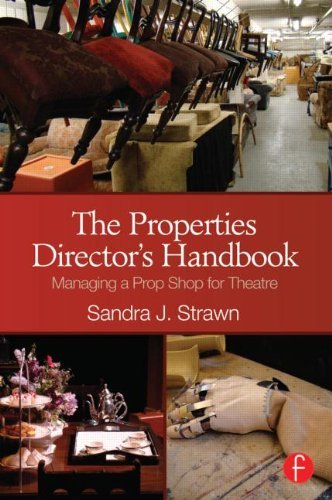
Props people have a new book that was just released today: The Properties Director’s Handbook, by Sandra J. Strawn. Longtime readers may be familiar with the website version of the Properties Director’s Handbook; I’ve mentioned it a few times over the years, and this blog has a link over along the sidebar.
Sandy also happens to be the technical editor for my book. Both of our books are being published by Focal Press. Between the two, they cover two of the major aspects of props: building props, and managing a prop shop. I asked Sandy a few questions about how the website came about and what we can expect from her new book.
What prompted you to first create the Properties Director Handbook website?
Sandy: I was prompted to initially start the handbook from the SPAM (Society for Properties Artisan Managers) discussions at our national conferences. As someone who has been doing this for almost three decades I realized many of our incoming prop masters were asking us “old timers” among the SPAM network many of the same questions: how to organize a shop, how to effectively manage a build, how to write a prop list and work with stage management in updates, etc. I also teach this as part of my arc of training in the prop curriculum. I found myself emailing out my handouts to folks in the business and they would often comment to me, “You should write a book.” I decided to try and compile the information in one spot and was granted a sabbatical from the University of Wisconsin Milwaukee to create my website. I wanted it to be a free textbook available to all those folks who teach the props classes in university programs, as well as to prop professionals or community prop people who need to understand the process of being a prop master or props director.
How has the website been translated into this new book?
Sandy:Â Seeing the success of my website, Focal Press expressed interest in making a book from part of the chapters I had on the website. Over the past summer I re-worked the webpage into a more condensed book form, now available online from Routledge Press and all the usual online book selling sites.
I have updated my website pretty much continuously since I created it in 2008. As I re-worked the chapters to make them over into a book, I ended up pretty much re-writing and updating everything. I did a new survey on prop salaries and contracts and that information is included in the book as well as some better illustrations of paperwork. The book covers about two-thirds of what is on the site and focuses primarily on the properties director’s process of taking a show from initial script reading through opening. These chapters tend to be the ones most viewed on my site and I think are the ones most relevant to those folks who are teaching prop classes. The web site has many more links and examples of prop lists, show reports, photographs of shops and props, and additional “chapters” on setting up a safe and happy prop shop. Anyone who utilizes the book will find the website a convenient resource for additional reading and research materials as well as interesting examples of prop work and prop shops around the United States.
I wrote this primarily as a textbook for undergraduate props training but I know many beginning prop professionals would find it useful as well. My hope is, in combination with your excellent book on the “how to do” part of making props, this book will help theatre folks understand the “how to manage” part of doing props.
What do you feel are the biggest misconceptions about what a prop director/master does?
Sandy: The biggest misconception about what a prop master does is about the range of skills an effective prop master must have in order to do the job well. Not only does the person need to be able to shop, but to create props the artisans must know sewing, welding and metal working, furniture construction and restoration, plastics construction, upholstery, faux painting, radio and pneumatic controls, calligraphy, graphics layout, molding and casting, leather work, painting and portraiture with acrylics and watercolors, floral arrangement, sculpture and 3D carving, especially with foam, electrical construction and wiring, crafts, photography, fabric dyeing and distressing, matting and framing, draping, fabric layout,  pattern making, musical instrumentation, weaponry, pyrotechnics… to name a few.
Layer that on to the management side of being a props director and master, where an effective prop person must be highly organized, creative, have an eye for detail, flair for design, creative adaptability (the “what if…”), be self motivated, and be willing to do all that and more as part of a collaborative design and production process. Whew! I’m exhausted just talking about it!
There is no prop “store” where we can run out and buy all the props; eBay comes close, but our budgets are never enough and those pesky designers always want something so specific it must be created in the shop. That’s what we do as prop people.





Congrats Sandy! Can I look forward to a double signing at USITT?